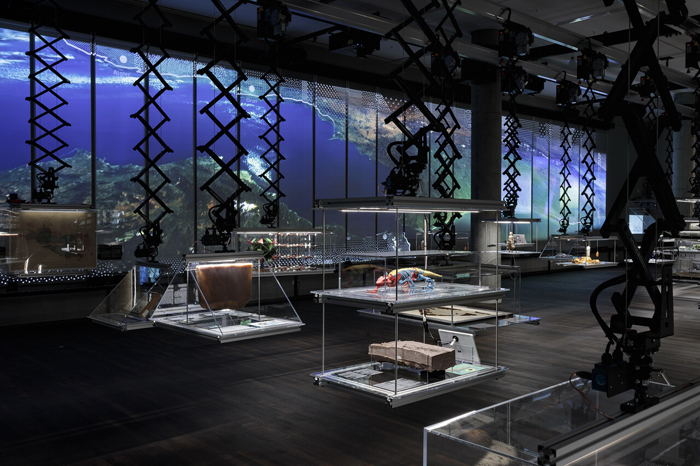Press Release
Berlin’s Humboldt University is breaking barriers and expanding the frontiers of science. The newly opened Humboldt Lab punctuates its intersection into society. Inside Outside—Petra Blaisse, in collaboration with Cookies and schnellebuntebilder, designed a contemporary Wunderkammer indebted to the impressive cosmos of academia brought forward ever since the founding of the Humboldt University in 1810.

International ongoing exhibitions
After Nature
Humboldt Lab, Berlin (Germany)
20.07.2021 - 31.12.2025

“Backstage of Science”
The focus is far from filing scientific achievements in a trophy cabinet. Humboldt Lab houses curiosities that are actively studied as much as showcased. Inside Outside created a sequence of architectural moments to trigger eager expectation proportional to being on the brink of a discovery. Transcribing dramatic reveal into architecture, the exhibition trails a large staircase, a gallery, a stage and, finally, uncovers the Humboldt Lab as the Backstage of Science.
A vivid, ever-
“Multiplying the Museum View”
The Main Hall is the knowledge-
A steel grid hung underneath the ceiling facilitates a motorized pantograph system designed in collaboration with Cookies. The pantograph system, taken from the television industry, allows for 38 research objects to be brought at eye-
The Main Hall also provides access to four archives that underscore diversity within their scientific disciplines, while engaging notions of collectivity and cross-
“Physical to Cerebral Engagement”
An interactive media screen that consists of 24 adaptive projections runs along the Main Hall’s wall. Designed by schnellebuntebilder and Jan Bernstein, it presents a visualization of pressing issues of our time, from man-
Beyond passive display, all showcases are carefully climatized, detailed and locally lit to fit the objects according to museum standards. The various heights and forms of each display invite visitors to engage visually, physically and emotionally. Color and graphic additions are strategically positioned to enhance the value of individual objects. The graphic layer was designed by Julia Neller in collaboration with Inside Outside and the curatorial team. It was implemented since the early design stages, in the spirit of reinforcing the diversity and non-
Backstage of Science.” © Humboldt University-
Exhibition July 20, 2021–December 12, 2025. Humboldt Forum, Schloßpl, Humboldt Lab, 1st floor – 10178 Berlin (Germany).


© ArtCatalyse International / Marika Prévosto 2021. All Rights Reserved